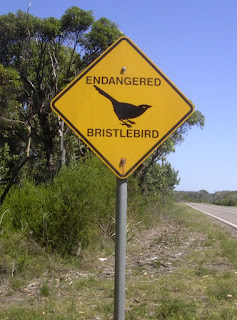Not far from Paperbark Camp, on the shores of Jervis Bay, is a National Park called Booderee Park, which we visited. 'Booderee' is an Aboriginal word from the Dhurga language meaning 'bay of plenty' or 'plenty of fish'. The park is owned by the Wreck Bay Aboriginal Community and has always been a significant place for Koori people. Incidentally, the total aboriginal population of Australia is about 550,000—or 2.7 percent of the population. There are hundreds of different aboriginal languages, reflecting the small groupings of people spread out over a huge continent.
The description in the Park Guide is very accurate:
“The crystal clear waters and rich variety of habitats in Booderee National Park and Botanic Gardens offer visitors a wide range of things to explore. With over 200 species of birds, 30 species of land mammals and 180 species of fish - Booderee National Park is a fantastic place to meet Australian fauna.”
One of the fauna is the endangered Bristlebird:
What motorists are supposed to do about them is unclear--perhaps like British wagtails they strut around in the road.
And one of the flora in the Botanic Gardens (where we were the only visitors) was this orchid:
The ‘crystal clear waters’ are at their best in Murray’s Bay, where for once the surf does not crash into the shore. The water is turquoise in colour, there is a fringe of palm and other trees, and very few people are on the soft, sandy beach. The headland shields the beach from the Pacific swell, making it an ideal swimming spot.
There is also a hiking trail—Murray’s Walk—that takes you on a loop up onto the high cliffs overlooking the ocean.
Wreck Bay Village itself now has an aboriginal population of about 200, living in neat little brick bungalows--obviously government built. The history of the community is probably typical: there was a much larger flourishing community in the 19th century, decimated by “disease, guns, and imprisonment.”
The road to Booderee runs through Huskisson, which students of British history will immediately realize was named after the British Cabinet Minister whose claim to fame is that he was the first fatal casualty of a train accident. He was killed in 1830 by Stephenson’s ‘Rocket’ at the opening of the Liverpool and Manchester Railway. Huskisson lies at the mouth of the creek that flows by Paperbark Camp.
Near Booderee, in the town of Vincentia, was a roadside bus shelter, irresistible to the digital photographer, with some of the best bus shelter murals we had seen. You wonder who does them, who plans them, how long did it take take them to do something so intricate.









No comments:
Post a Comment